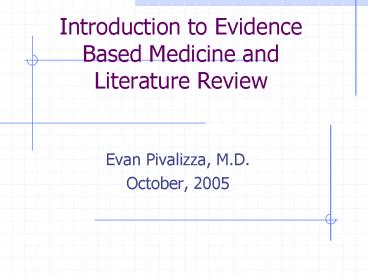Introduction to Evidence Based Medicine and Literature Review - PowerPoint PPT Presentation
1 / 23
Title:
Introduction to Evidence Based Medicine and Literature Review
Description:
Origin 70's principles delivery health care ... Caudal. PONV. 5. Postanesthetic care. Fluid, hemodynamic, nutrition, infection ... – PowerPoint PPT presentation
Number of Views:164
Avg rating:3.0/5.0
Title: Introduction to Evidence Based Medicine and Literature Review
1
Introduction to Evidence Based Medicine and
Literature Review
- Evan Pivalizza, M.D.
- October, 2005
2
- Background
- Cochrane, Sackett
- Origin 70s principles delivery health care
- Promote RCTs most reliable source evidence based
decisions - Comprehensive catalog valid trials
3
EBM
- Conscientious, explicit, judicious use best
evidence make decisions individual patients - De-emphasizes (not eliminate) intuition,
unsystematic clinical experience - Integrate clinical expertise best available
evidence - Emphasizes systematic evaluation evidence from
clinical research - ACGME core category resident education
- Practice based learning, medical knowledge,
patient care
4
Principles
- Ask clear, focused question can be answered
- Who is it about?
- Which treatment/maneuver considering?
- What desired outcome?
- Search evidence
- Cochrane library, Medline etc
- Critical appraisal evidence
- Are results important?
- Are results relevant/valid?
5
- 4. Clinical applicability findings (does apply
this patient)? - Not in original study (age, morbidity)
- Subgroup analysis (male, female)
- 5. Evaluation process
- Did ask right (any) question?
- Is anything we can do better?
6
- How Critically Appraise evidence
- Study design?
- What is intervention, and compared to what?
- Randomized?
- Blinded? researchers, patients, assessors
- Prospective?
- Were all patients accounted for?
- What outcome?
- Appropriate statistics?
- Is conclusion justified by results?
7
Types publications (? importance)
- Case Report Select patient specific
condition/outcome - Case Series Select group patients
- Cross-sectional study Comparison characteristics
and endpoint of sample patients
8
- 4. Case-control study Comparison group with
outcome to group without, in terms particular
characteristics - 5. Cohort Comparison gt 2 groups, with and
without characteristic, in terms of outcome - 6. Clinical trial Comparison gt 2 groups,
randomized to treatment groups, terms of outcome
9
RCT
- Quantitative, comparative, controlled experiment
- Randomization ? risk imbalance unknown factors
could influence - Open to manipulation (bias) up to 30-50 change
- Historical control overestimate 30-40
10
- Execution of trial
- Size Was large enough, sufficient duration?
- Drop-outs ? bias
- Intention to treat all pts included in
analysis in group assigned, whether completed or
not - Methods What were interventions, by whom, how?
- Statistics Another session
11
- RCT ? Systematic review
- Scientific strategies to decrease bias in
- Collection
- Appraisal
- Interpretation
- Statistics
- Collating RCTs
12
- Clear question
- Clear method selection RCTs
- Language
- Inclusion, exclusion criteria
- Statistical method (expert)
- ? power (number) of study
13
1. ASA practice parameters (04)
- Designed provide guidance/direction mx pts
- Anesthesiologists leaders development/adoption
- Standard Rule, minimum requirement, generally
accepted principles. - Guideline Systematic recommendations
management strategy. NOT intended as standards
14
- C. Advisory Systematic reports (expert opinion,
consensus surveys, open forum commentary,
clinical feasibility data) assist decision making
- Summarize state literature, report opinions task
force - NOT supported scientific evidence same extent
stds/guidelines (insufficient) - D. Alert Facilitate awareness problem patient
safety
15
- Perioperative Mx Cardiac Rhythm Device (05)
- Cannot guarantee specific outcome
- Adopted, modified, rejected according clinical
needs, constraints - Basic Anesthesia Monitoring (04)
- Apply to all anesthesia care, although in
emergencies, appropriate life support measures
precedence - Delineation clinical privileges (03)
- Assist physicians/organizations develop program
16
2. ACC/AHA guidelines
- 2002 ACC/AHA Guideline Update for Perioperative
Cardiac Evaluation for Noncardiac Surgery - Systematic approach, literature based, specific
recommendations/algorithm - Already 3 years old
17
- ACC/AHA Classification Recommendations
- Class I Evidence/general agreement procedure
useful/effective - Class II Conflicting evidence/divergence opinion
- IIa Weight evidence favor efficacy
- IIb Efficacy lt well established
- Class III Evidence/general agreement
procedure/treatment not useful/effective,
possibly harmful
18
- Level of Evidence
- A Multiple RCTs/ meta-analyses
- B Single RCT, or nonrandomized studies
- C Consensus opinion experts, or Case studies, or
Standard of care
19
3. Cochrane Anesthesia Review Topics
- International organization ? systematic reviews
multiple topics (Anes Analg) - 1. Ambulatory Anesthesia
- Anesthesia for ECT
- 2. Anesthesia and Medical Diseases
- Preop evaluation
- 3. Drugs in Anesthesia and intensive care
20
- 4. Perioperative care
- Caudal
- PONV
- 5. Postanesthetic care
- Fluid, hemodynamic, nutrition, infection
- 6. Regional Anesthesia
- Protocols developed
- 7.Technology in Anesthesia
- Pulse oximetry
21
Summary EBM
- Seek best evidence (RCT)
- Unavailable ? observational studies
- Unavailable ? (own) systematic clinical
observations, pathophysiologic reasoning - Little evidence (yet) from RCTs that practice
EBM ? improved patient outcomes - IS evidence (reliable) knowledge RCTs ?
evidence-based therapy ? ? outcome
22
- Make clinical decision making
- Explicit
- Conscious
- Science based
- Supplement, not supplant other approaches patient
care/ teaching
23
References
- Pronovost PJ, Anes Analg 2001 92 787
- Pedersen T, Acta Anaesthesiol Scand 2001 45
267 - Moller AM, BJA 2000 84 655
- Cochrane review topics (www.cochrane.org/reviews)






























